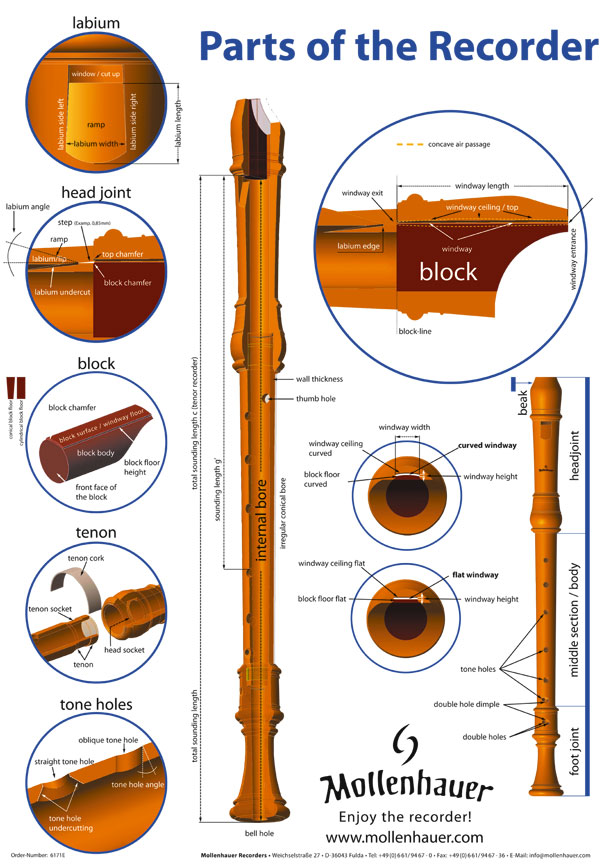Baroque & German Fingering

Most school recorders are still offered with German and Baroque
fingering so that a choice must be made at the time of purchase.
The most important difference is the fingering for the note F (soprano) that at first is easier to finger in the German fingering
system (in comparison to the forked fingering of the Baroque system, see below). However, this apparent ease of fingering seriously
compromises the tuning of the instrument in other keys than the home key. Even F-sharp requires more complex fingerings in order to
sound reasonably in tune.
For this reason modern recorder tutor books are geared towards Baroque fingering which – when taught properly – is no more difficult
for pupils to learn.
A common error:
often the double finger holes C /C-sharp and D/D-sharp (soprano) are regarded as evidence of Baroque fingering. However, the double holes are possible in both fingering systems.
The Baroque fingering can easily be recognised by the larger finger hole for F (soprano), B-flat (alto) in comparison to a German fingered instrument.
Why do Recorders Require Oiling?
The body of a wooden recorder needs to be protected against moisture generated during playing, climatic conditions and dirt. Oiling helps to maintain the beauty of sound and response; without it the wood will age too quickly and change its measurements by swelling and subsequently drying. Also, recorders with a very dry bore will become slightly flat. You can use any plant oil that is not too dense such as pure sweet almond oil, linseed oil or the cheaper peanut oil (though the latter can cause allergies in nut-sensitive people). However, these oils can dry too quickly or become rancid. Therefore we recommend using special recorder oil available from specialist shops – this is modified boiled linseed oil that helps the oil to be absorbed quickly.The frequency of oiling depends on the demands placed on the instrument by playing and also from environmental conditions. The initial treatment will wear off over time due to the moisture generated during playing and dry atmospheric conditions (especially in winter). In general, a moderate coat of oil should be applied 3–4 times per year. As soon as the wood looks grey or brittle it will require oiling again.However, there is one exception: both the roof of the windway and the block need to be able to clear away any condensing moisture from the windway. This should happen as a thin film (of water) running off the surface. If windway and block have an oily surface droplets will form and cause disruption to the flow of air and tone production, causing hoarseness. This is the reason why both block and windway must never be oiled.You find more info on this topic in Oiling – a detailed explanation.
How do I Oil my Recorder?
All unvarnished wooden surfaces of the instrument require oiling – apart from the block and the windway. These must not be oiled under any circumstances as condensing moisture from the breath would not be able to form a thin coating and run off. The bore and all fingerholes should be oiled regularly if they were not varnished by the maker.You will find more on this topic in our YouTube video and also under the headings Oiling – a detailed explanation and What sort of oil do I use for the keys.
More Information you can find in the following Video.
How often does a recorder need to be oiled?
This depends on how much the instrument is used and also on atmospheric conditions. In general a moderate coat of oil should be applied 3-4 times per year. As soon as the wood begins to look grey or brittle it will require treatment with oil.
What Sort of Oil do I Use for my Recorder?
Basically, there are two different kinds of oil:
- mineral oils that are derived from crude oil (used for the moving parts of recorder keys)
- plant oils that should be used for the care of the wooden body of the recorder.
Plant oils
Plant oils harden in the pores of the instrument’s wooden bore. As a result the resonance of the instrument will be improved. The faster the oil dries the sooner the instrument can be used again. It doesn’t harm the instrument if it is played before the oil has dried but the packing case might develop unsightly stains from contact with the oil. The time that it takes for the oil to harden depends on the oil used and also on the type of wood used for the recorder. Some oils contain added drying agents but these can cause allergic reactions. This is why pure oils should be used, particularly around the beak where there is continous contact with the player’s mouth..
Oils that can be used include linseed oil, sweet almond oil, tung oil.
Linseed oil is produced from the seed of flax – linseed – and is a drying oil. It contains many polyunsaturated fatty acids that react with oxygen to give a hard protective surface. The first rule when using linseed oil is that all wipes and cloths should be stored in a tightly closed screw top jar so that no oxygen can come into contact with them. Care is to be taken with oily cloths – there is a danger of spontaneous combustion. Do take notice of the manufacturer’s instructions and general precautions. Wipes and cloths that have been stored in an airtight jar can be re-used for subsequent oiling sessions.
Wischer und Lappen, die luftdicht aufbewahrt wurden, können für die nächste Pflegeaktion wieder verwendet werden.
Sweet Almond oil: this oil has a low viscosity and dries much more slowly; it is almost odourless and therefore often prefered by people with a sensitive sense of smell. It has a much lower tendency to self-ignite than linseed oil. However, in comparison to linseed oil it doesn’t harden as much and therefore does not last as long.
What sort of oil should be used for the recorder keys?
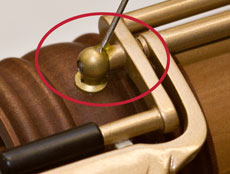 Mineral oils are used for the maintenance of the moving parts of the recorder keys – these oils do not harden. If you were to use plant oils the keys would become absolutely solid once the oil had dried.”Key oils“: these consist of refined crude oil and are comparable to common ”bike oil“ or ”sewing machine oil“. The viscosity of ”key oils“ is such that they are sufficiently viscous (thick) to keep the moving parts greased, yet thin enough to enable free movement of the keys.
Mineral oils are used for the maintenance of the moving parts of the recorder keys – these oils do not harden. If you were to use plant oils the keys would become absolutely solid once the oil had dried.”Key oils“: these consist of refined crude oil and are comparable to common ”bike oil“ or ”sewing machine oil“. The viscosity of ”key oils“ is such that they are sufficiently viscous (thick) to keep the moving parts greased, yet thin enough to enable free movement of the keys.
Important: key oil must be used sparingly to avoid contact with the wooden body of the instrument and the key pads and risk damage to their surfaces.
Music specialist shops supply very good oils suitable for the maintenance of the keys. The oil should not be so thin that it only lasts for a very short time. Mollenhauer recommend the "mechanic oil for woodwind-instruments" from the company Kreul in Germany.
What is the Block of a Recorder Made Of?
The block of a recorder is made of cedar wood. This grows in Kenya and Florida, is beige or red in colour, and swells very little when it comes into contact with water. This property is very important for ensuring that the measurements of the windway change as little as possiible.
The block is inserted into the headjoint of the recorder from the top end and consists of the block plug and the block surface. The block surface has to be very smooth and clean so that the flow of the airstream does not meet with unnecessary resistance and cause turbulance in the air flow.
Apart from the traditional cedar wood Mollenhauer also uses a new material for the block: synpor, a synthetic material with wood-like characteristics that combines high moisture absorbency with resistance to swelling. This material is mainly used in instruments that will be subject to particularly high demands – synpor blocks are standard in Modern Sopranos and Modern Altos as well as in Helder Alto and Tenor recorders.
Hoarseness – a Problem in Recorders
There are two reasons for hoarseness in recorders and these often arise together: one is caused by the formation of droplets in the windway, the other by the swelling of the block. Both cause the carefully designed proportions of the windway to narrow and so to bring them out of alignment.
Hoarseness caused by condensing breath moisture:
When will hoarseness occur?
It can happen in new and cold instruments. The ”playing in“ process of new recorders accustoms the wood to its new purpose. Cold instruments should always be warmed.
Why does hoarseness occur?
The upper layers of the wood in the windway still contains natural substances (eg wax and oils) that will be washed out in the first days of playing. Moisture from condensing breath will collect on these remnants, form droplets in the windway and so hinder the airstream.
Remedy – how?
the process of ”playing in“ should be conducted in several short sessions for the reasons given above. If it becomes absolutely necessary Anticondens may help in the first few days. After a period of about 3 weeks the disturbance through water droplet formation should diminish. If the hoarseness persists despite ”playing in“ the recorder should be returned to the Recorder Clinic for revoicing.
It is always useful to warm the instrument before playing. The headjoint in particular should have reached body temperature before playing. This will reduce the moisture from condensation of the breath in the windway – provided that the room temperature is not too low.
Hoarseness caused by swelling of the block:
When does it happen?
In new instruments when the cedar block swells due to excessive demands from breath moisture and does not return to its original measurements.
In instruments that haven’t been played for a while and where the block has dried out.
Why does it happen?
During playing in, the cedar block absorbs some moisture from the breath. This might cause it to swell. The potential for changes to the windway measurements are taken into account by the maker when voicing the recorder. However, if the block swells more than anticipated the sound of the instrument changes. It becomes thin and squeaky, high and low notes will no longer respond easily.
Remedy - how?
If the block of a recorder has swollen too much Anticondens will no longer help. The instrument will have to be readjusted in the Recorder Clinic. Mollenhauer offers this service for new instruments for a period of 2 years free of charge.
The thumbhole has worn
worn thumbhole will have a detrimental effect on both tuning (intonation) and response of a recorder – particularly in the higher register. It is best to have the instrument thumb-bushed in our Recorder Clinic (see illustrations).
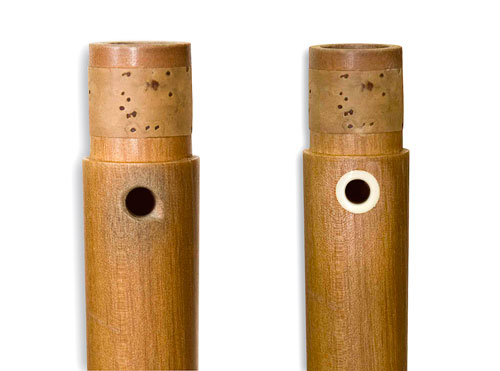
Before After
Precious wood – what is this?
Only a few woods are suitable for recorder making. Criteria are regular growth, suitable specific weight, trunks of sufficient diameter, well seasoned wood without cracks and with only very few knots, and that maintains its dimensions under playing conditions.
Woods suitable for recorder making should:
-
reflect the sound well (dense surface)
-
be resistant to swelling and shrinkage
-
not cause allergic reactions
-
support the aesthetic appearance of the instrument
-
come from ecologically sustainable forests.
All woods that fulfil the conditions listed above can be considered suitable for recorder making. The widely held opinion that only woods from overseas can be regarded as precious woods needs to be corrected.
Native precious woods include European Boxwood, Plum, Pear and Maple.
How does the Wood Influence the Sound?
Every wood has a particular structure:
The traditional woodwind industry does not only use native precious woods; woods from tropical countries or savanna regions have been imported for hundreds of years. Woods differ in density, hardness and structure and also in colour and grain. All these components contribute to the slightly different surfaces of the various woods.
These differences alter:
-
the flow of the airstream in the windway
-
the reflection of the sound waves inside the recorder and so the entire sound.
A basic rule is:
Hard wood sounds harder and has more overtones, however, the more brilliant sound is less flexible.
Soft wood sounds softer, has a relatively stronger fundamental, blends better and has a more flexible tone.
Thus softer wood is recommended for ensemble playing but also for a pleasing high register that modulates easily. For solo work and in particular in an ensemble with different modern instruments a harder wood with a strong tone, rich in overtones is to be prefered.
For more information go to Types of wood.
What Influences the Sound?
There are two basic factors that influence the sound of a recorder:
The playing technique of the musician as well as the type, quality and condition of the instrument being used.
Breathing Technique
Unlike other wind instruments the recorder does not require a special embouchure as such; the quality of sound is determined by the way the air stream flows into the instrument. The mouth cavity is the decisive factor in that it acts like a dosing valve. Its spatial volume is restricted by the hard palate but can be changed by muscular movements. These influence the shape and position of the tongue, the position of the larynx and the lower jaw as well as the tension and shape of the lips and their surrounding area. Any change to the shape of the mouth cavity will result in different paths for the airstream and cause different points of friction, breath pressure and bundling of air. This is likely to influence the quality of sound produced in a positive or a negative manner. Proficient players put these variants to deliberate and creative use. Not only will this affect the response in the different registers but also vary the wind noise or purity of the recorder sound produced and can thus be used to advantage for musical expression.
This kind of flexible embouchure must be supported by a stable air column – depending on the model of recorder used. Modern woodwind players refer to this as breath support. For a beautiful recorder sound fine control provided by stomach and flank muscles is just as important.
The instrument
The recorder is a rich sounding instrument with a long history and is available in various models and sizes. Depending on playing standard and purpose you can choose from school instruments, copies of historic models and also modern recorders. Most of them are produced in families, that is in different registers and sizes, so when selecting a recorder it is useful to consider what sort of music the instrument will be used for. Every model differs from the others in its characteristics and so will be more suited to a particular kind of music than others: a Renaissance consort recorder has a round sound that blends easily and is well suited to ensemble playing. A Baroque recorder is better suited to solo playing and has a clear, bright tone. Modern recorders are powerful instruments with tonal stability that modulate easily, have an extended range of notes and are particularly suited to playing with other modern instruments. School recorders have a neutral tone and so are best suited to helping develop an individual sound. Only an instrument that is well looked after will be a reliable partner for optimal sound production and will be capable of expressing its particular characteristics to the full.
How Does a Recorder Develop Cracks?
Wood is a natural and uniquely grown material that is prone to internal and external influences. Therefore it never quite remains completely stable in size and shape. It periodically swells and contracts within a range of a tenth of a millimetre throughout its life. A woodwind maker tries to take this natural process into account by allowing for some movement and by applying various preserving processes. The player likewise should look after his instrument by adopting thoughtful playing habits, careful maintenance and considering changing atmospheric conditions. But despite the greatest care wood can change unpredictably – both positively and sometimes negatively. The worst case scenario is that it develops hairline cracks or even open cracks.
Causes may be:
-
Corked joints can become stiff due to the wood moving or being greased too little
-
External forces
-
Cracks can be caused by sudden changes of humidity or temperature
-
Ageing wood: wood can change its shape over time – the round body can warp or become oval.
The High Notes do not Speak Easily or are Unobtainable.
-
Check breath pressure
-
Check thumb position
-
Check damage to the thumbhole (worn or irregular edge of thumbhole ) caused by the thumbnail
-
Swollen block: over time the block may have changed its dimensions – the block surface may have risen and as a result the windway will have narrowed
-
There may be dirt in the windway
What do I do? The recorder clinic will check the faulty instrument. It may need a thumb bushing and/or re-voicing.
The Low Notes do not Speak Easily or are Unobtainable.
-
Fingerholes are not completely covered
-
Corked joints are leaking
-
Cracks have developed
-
Keys have become faulty: key pads leak, key mechanism may not be aligned
-
The bore may require oiling
-
The block may be swollen: over time the block may have changed its dimensions – the surface may have risen, thus narrowing the windway
-
There may be dirt in the windway
-
The cleaner is stuck in the instrument (yes, in fact it happens quite often!)
What do I do now?
-
Check that fingers cover the holes completely
-
Check joints
-
Have cracks repaired in the recorder clinic, possibly by adding a decorative ring.
-
Have keys checked at the recorder clinic
-
Oil the bore
-
Send instrument to recorder clinic for corrections to block or windway
-
Do not leave the cleaner inside the instrument, for example in order to store it there.
Mould in the Windway and on the Labium. Why?
The recorder was probably packed away while damp. In order to remove the mould from the recorder permanently, please send it to the Recorder Clinic where, in consultation with you, it can be treated.
In order to avoid mould you should take the following precautions: recorders must be allowed to dry slowly after playing: take the instrument apart, dry it well and blow the remaining moisture out of the windway (please watch the video about Blowing out a recorder). Leave your instrument to dry in the open, not in the closed box or bag.
Why do I Need to Warm the Recorder Before Playing?
Warming the instrument before playing is a preventative measure that also improves playing. The player’s breath is usually much warmer than the ambient temperature. As the recorder has adjusted to this external temperature, playing the instrument from „cold“ will result in a temperature difference that may lead to great stress in the body of the recorder which can result in cracks. In order to avoid these cracks the instrument should be warmed in the hand or near the body. As the difference in temperature will affect the head joint most, this should receive preferential treatment in warming before playing. Another important result of warming the instrument before playing will be that it will not become hoarse so easily. Small droplets of condensation form in the windway when warm breath comes into contact with a cold instrument, as a result the windway narrows and playing will be affected. The fewer droplets that collect, the more stress-free the music making. Also, instruments are much less likely be in tune unless they are warm
The Labium of the Recorder is Damaged ...
If the edge of the labium has become damaged the tone cannot develop in the usual way. The result is often a burbling sound and the response in the extreme registers will be very poor. The only remedy is a new headjoint. Please send the instrument to the Recorder Clinic.
Please note: we can only replace Mollenhauer recorder parts. For other instruments please contact the maker.
The Tenon of the Recorder has Broken Off
A broken tenon makes a recorder useless as the adjacent recorder parts can no longer be fitted together. Cracked tenon joints cannot usually be glued as, in order to have the closest fitting joint, they will have to be resistant to relatively high pressure. In these cases the middle or foot joint will have to be replaced. Please send the instrument to the Recorder Clinic.
Please note: we can only replace Mollenhauer recorder parts. For other instruments please contact the maker.
What Should I do if the Cork Comes Off?
If, over a period of time, the cork comes away from the wood the stability and tightness of the seal of the tenon joint can no longer be guaranteed. The cork should be replaced as soon as possible by a specialist because faulty tenon joints can lead to more permanent damage - for instance, the loose cork can become stuck in the tenon socket making the parts inseparable or alternatively the loose parts of the recorder may fall apart too easily. For best results please send the complete instrument to the Recorder Clinic.
How do I Deal with Problems with Recorders from Other Makers?
Because all models of recorders have been made to specific measurements and designs it is best to return faulty instruments to the original makers. However, many customers ask us to repair instruments from other makers. Although we do not like to tamper with these, we are happy to carry out some minor repairs, maintenance and overhauls. Please send your instrument to the Recorder Clinic.
My Recorder is no Longer in Tune.
Do you think that the tuning of your recorder has changed? This can happen through normal playing: the interaction of moist breath and subsequent shrinkage (for instance due to dry atmospheric conditions in centrally heated rooms) occasionally prevents the wood from regaining its original measurements. The result will be notes that differ from the original pitch. In this case you should send your instrument to the Recorder Clinic for the tuning to be corrected.
The Keys do not Work Smoothly.
Only a fully adjusted key mechanism will guarantee reliable, trouble-free playing. However, keys can bend slightly: this can be caused by careless assembly of the instrument parts, by faulty storage in a soft case or by accidental damage. Keys that are bent no longer move parallel to the axle. Consequently, the key will no longer be the correct distance from the fingerhole and the key pad will not cover the hole properly. The result is problematic intonation and poor response. The key mechanism can usually be adjusted by instrument makers; key pads are expendable parts (they can become brittle with age or get damaged through contact with oil). To guarantee easy movement all metal parts should be checked by a specialist at regular intervals.
In this case please send your instrument to the Recorder Clinic.
Thumbrests
For improved balance or better support of a large or heavy instrument there is a simple remedy: the well proven thumb rest for the lower hand. This is fixed to the instrument so that the supported thumb will carry a large proportion of the weight. There are two different kinds of thumb rests: a basic wooden thumb rest that can be easily positioned and that you can fit yourself. The second type is a more durable and (depending on the design) adjustable thumb rest made from metal with a cork pad. This should only be fitted by a specialist. Both types of thumb rest are available from our stock. The fitting can be carried out in our Recorder Clinic.
Cracked Head or Foot Joint. Is that the End of the Recorder?
Changes in the wood are part of the ageing process. These include: shrinkage, changing dimensions, periodic swelling and subsequent shrinkage caused by moist breath and atmospheric conditions, also possibly cracks resulting from stress. Cracks endanger the solidity of the recorder body. To ensure they do not open up wider they should be stabilised as soon as possible. Generally speaking all cracks can be repaired in a specialist workshop. The determining factor is where the crack has appeared: places that are under considerable stress such as the beak (that surrounds the block and is therefore particularly affected by its swelling) and the tenon joints (where the corked or threaded tenons exert pressure onto the socket to form a secure joint) usually require a wooden or plastic sleeve in addition to glueing in order to fix the crack securely and permanently. These repairs do not influence the sound quality of an instrument as long as the cracks do not affect the windway or the inner bore. In some cases even cracks that go all the way through can be repaired by an instrument maker. You only need to consider old string instruments: hardly any of them have survived without any cracks at all; nobody would discard them for this reason. In order to obtain specialist advice please send your cracked instrument to the Recorder Clinic where the necessary repairs and options will be discussed with you.
The Block is Loose. What do I do?
Every wooden recorder consists of two different kinds of wood: the wood of the recorder body and the wood of the block (usually cedar wood). Because these woods have different characteristics it is obvious that both react differently to warm, moist breath and subsequent drying as well as to atmospheric conditions. Therefore it can happen that the dimensions vary to a different degree, affecting the precise fitting of the different parts. In extreme cases the block swells so much that it can hardly be removed for cleaning or repairing. On the other hand, the block can become so loose (the instrument will leak air and moisture) that it can move or even fall out and become damaged. Only a perfectly fitted block guarantees an optimal sound, therefore we recommend having the recorder repaired by a specialist. Wherever possible he will try to rescue the original block. If this isn’t possible a new block will have to be fitted and the instrument will have to be voiced from new. You should therefore send your instrument to its maker who will have suitable replacement blocks available.
Please send Mollenhauer recorders to our Recorder Clinic.
The Tenon Joint is Very Loose or Too Tight
A recorder consisting of more than one part is fitted together by tenon joints. Flexible seals ensure a neat fit and a stable sound. These consist either of a modern corked joint or a (more traditional) threaded joint. School recorders may have a rubber seal. All these different seals may wear through use and must be carefully maintained.
The Corked Joint
Modern corked joints consist of naturally grown cork or composite cork (glued cork particles). Cork or composite cork are elastic, durable and tightly sealing natural materials but may shrink depending on the demands made on the instrument, it may also become brittle and less flexible. Proper care can extend the life of cork joints considerably. Therefore cork should be greased at regular intervals. Please use our joint grease or grease stick available as an accessory. Whenever the cork appears dry and the joints do not glide sufficiently smoothly together it needs to be greased. Please make sure you do not apply too much grease – the cork should never be soaked in grease because this will disolve the cork adhesive.
-
If the cork joint has become loose the cork strip can be replaced quite cheaply by a specialist workshop. For best results you should send the entire instrument to the Recorder Clinic.
-
If the cork joint is very stiff you should apply some grease to the dry and brittle joint immediately. Other factors can contribute to stiffness: if tenon and socket absorb moisture during playing, they can expand to such an extend that they can only be turned or taken apart with difficulty or even not at all. In order to avoid this dry out the instrument every 20 minutes. However, if it does happen that the instrument cannot be taken apart it is better to wait until it has dried sufficiently than to use force to separate the parts. In some cases it can happen that the tenon has swollen permanently and is too stiff. This problem requires immediate treatment in the Recorder Clinic as the excessive stress may cause cracks in the adjacent areas.
Threaded joints
A reliable threaded joint consists of high quality cotton thread which has been impregnated with wax at the time of fitting. This ensures that the thread glides more easily, is more secure, seals better, and repels moisture that collects in the joint. Because a threaded joint can become dry and brittle, and as a result tear, it must be greased at regular intervals. Use our joint grease or a grease stick available as an accessory. Please make sure you do not use too much – the thread should not be soaked through with grease as the thread fibres will become hard and this would lead to loss of elasticity and stability.
-
If the thread has become loose you can easily add more similar thread.
-
If the thread is too stiff you should try and ease it by adding a little grease to make it glide better. You must never try to cut off any of the thread as the entire joint may unravel. This problem should be treated in the Recorder Clinic as soon as possible as a stiff threaded tenon may become stuck in the socket and make it impossible to separate the parts. It may also lead to cracks in the head or foot joint.
Useful hint: in addition to greasing the tenon you can also apply a little grease to the socket. This has a beneficial effect on the smooth operation of the joint. Please remove any surplus grease immediately to avoid the risk of unsightly stains on the wood or in the fingerholes.
The Rubber Ring Seal
Some school recorders have been fitted with maintenance-free rubber seals (rather than cork). These do not require any greasing and are therefore particularly suitable for small children.
-
If the joint between the head joint and the middle joint has become loose or if the rubber seal has been lost the rings will have to be replaced. To do this the instrument will not have to be returned to the maker. We are happy to send you spare replacement rings without charge which you can easily fit yourself. Please contact us using this form.
-
If the rubber seal has become too stiff on an instrument made from a combination of wood and plastic, you should not try to ease it by applying grease. The cause may be that the instrument has consistently over a period of time not been dried after playing. The result is a swollen tenon. This problem should be attended to without delay by our Recorder Clinic – there is a small charge for this. Alternatively the tenon may become so stiff that the head joint can no longer be separated from the body and in extreme cases the tenon can break off.
The Keys on my Recorder are Noisy.
 The key mechanism of a recorder requires maintenance too. Just as cork joints should be greased occasionally so the keywork hinge points require lubrication for ease of movement. A drop of oil is usually all that is required (see photo). Good key oils are available from specialist music shops. The oil should not be too thin as it would not be durable. It must be used sparingly because any surplus oil will damage the surface of the wood or the key pads. Mollenhauer recommends the "Mechaniköl für Holzblasinstrumente" of the German Workshop "Kreul".
The key mechanism of a recorder requires maintenance too. Just as cork joints should be greased occasionally so the keywork hinge points require lubrication for ease of movement. A drop of oil is usually all that is required (see photo). Good key oils are available from specialist music shops. The oil should not be too thin as it would not be durable. It must be used sparingly because any surplus oil will damage the surface of the wood or the key pads. Mollenhauer recommends the "Mechaniköl für Holzblasinstrumente" of the German Workshop "Kreul".
If oiling does not solve the problem please send your instrument to the Recorder Clinic.
How do I Clear the Windway of my Recorder?
Do not place your finger on the labium under any circumstances. The labium will have become moist during playing and may, therefore, be elastic. If you press with your finger on the labium, it will easily bend downwards and the angle will be altered. It is much better to clear the windway in the following way: blow into the window while at the same time tightly covering the opening of the headjoint with one hand. Surplus moisture will be blown out and can be wiped off at the beak.
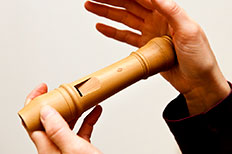
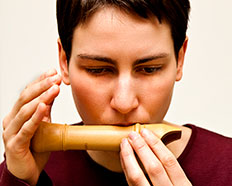
How do I Keep the Windway Clean?
The composition of the bacterial flora in the mouth differs from one person to another and this will influence what deposits the breath carries into the wind way. In addition, oral hygiene will also have an impact on residues in the windway. Over time the tiniest deposits will collect in the windway and disturb its carefully designed proportions and might even attack the wood. As a result the recorder will become hoarse more frequently and consequently will have a shorter lifespan. In order to reduce this contamination we recommend you brush your teeth before playing. If a toothbrush is not at hand use dental chewing gum.
Your instrument should be regularly serviced by a specialist to ensure that the windway remains in good condition. You are welcome to send your instrument to the Recorder Clinic to have this work carried out.
Tuning pitch (chamber pitch)
Musical instruments need a common tuning pitch so that they can be played together. Before there was an international agreement on a common tuning pitch every town, sometimes even varying from one institution to another, had its own tuning pitch. The variations were sometimes as wide as several semitones. During the nineteenth century, various committees strived towards a standardisation of the tuning pitch. In 1858 the international agreed chamber pitch at a1=437.5 cycles per second. In 1935 this measurement was named after the German physicist Heinrich Rudolf Hertz. Since 1939 the internationally agreed standard pitch has been set at a1=440 Hertz (abbreviated to Hz). Nowadays most recorders are tuned to a1=442 Hz in order to be able to play with other instruments more easily.
However, in historic music practice other tuning pitces are used: Renaissance music occasionally uses a1=466 Hz, French music of the high Baroque era a1=392 Hz; the pitch for music of the mixed high baroque period has been normalised at a1=415Hz. That is exactly a semitone below the modern pitch at a1=442Hz.
These days tuning is usually checked with the aid of digital tuning metres. Previously people used tuning forks.

















